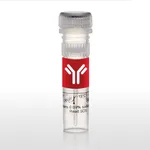Thermo Fisher Scientific TLR3 Polyclonal Antibody
다른 상품 둘러보기
Applications
Tested Dilution
Publications
Western Blot (WB)
1-3 µg/mL
View 1 publication 1 publication
Immunohistochemistry (Paraffin) (IHC (P))
1:100
Immunohistochemistry (Frozen) (IHC (F))
1:20-1:1,000
Immunocytochemistry (ICC/IF)
-
View 1 publication 1 publication
Flow Cytometry (Flow)
1 µg per million cells
View 1 publication 1 publication
Dot blot (DB)
Assay-Dependent
Product Specifications
Species Reactivity
Human, Mouse, Pig
Published species
Mouse
Host/Isotype
Rabbit / IgG
Class
Polyclonal
Type
Antibody
Immunogen
A mix of synthetic peptides corresponding to amino acids 135-150, 828-844, and 876-891 of TLR3/CD283 protein.
Conjugate
Unconjugated Unconjugated Unconjugated
Form
Liquid
Concentration
1.0 mg/mL
Purification
Protein G
Storage buffer
PBS
Contains
0.05% sodium azide
Storage conditions
Store at 4°C short term. For long term storage, store at -20°C, avoiding freeze/thaw cycles.
Shipping conditions
Ambient (domestic); Wet ice (international)
RRID
AB_2540632
Product Specific Information
Suggested positive control: mouse spleen lysate or protein.
Target Information
TLR3 (Toll-like receptor 3, CD283) is a member of the Toll-like receptor (TLR) family which plays a fundamental role in pathogen recognition and activation of innate immunity. TLRs are highly conserved from drosophila to humans and share structural and functional similarities. TLRs recognize pathogen-associated molecular patterns (PAMPs) that are expressed on infectious agents, and mediate the production of cytokines necessary for the development of effective immunity. The various TLRs exhibit different patterns of expression. TLR3 is most abundantly expressed in placenta and pancreas, and is restricted to the dendritic subpopulation of the leukocytes. TLR3 recognizes dsRNA associated with viral infection, and induces the activation of NF-kappaB and the production of type I interferons. Further, TLR3 may play a role in host defense against viruses, and the use of alternative polyadenylation sites to generate different length transcripts has been noted for the TLR3 gene. Like its counterparts in Drosophila, TLRs signal through adaptor molecules and could constitute an important and unrecognized component of innate immunity in humans. The TLR family is a phylogenetically conserved mediator of innate immunity that is essential for microbial recognition. TLRs characterized so far activate the MyD88/interleukin-1 receptor-associated kinase (IRAK) signaling pathway. TLR3 is the only human TLR which does not utilize MyD88 as an adaptor molecule instead utilizing TRIF in a signaling path which results in downstream activation of IRF-3 and NF-kB. TLR3 activation leads not only to Type I interferon induction but also to other inflammatory cytokines which result in DC maturation. TLR3 is known to recognize viral double-stranded (ds) RNA, a molecular pattern associated with viral infection. Recently it has been shown to recognize viruses such as Influenza A and West Nile Virus and can mediate entry of at least West Nile Virus.
For Research Use Only. Not for use in diagnostic procedures. Not for resale without express authorization.
배송/결제/교환/반품 안내
배송 정보
| 기본 배송비 |
| 교환/반품 배송비 |
|
|---|---|---|---|
| 착불 배송비 |
| ||
| 교환/반품 배송비 |
| ||
결제 및 환불 안내
| 결제수단 |
|
|---|---|
| 취소 |
|
| 반품 |
|
| 환급 |
|
교환 및 반품 접수
| 교환 및 반품 접수 기한 |
|
|---|---|
| 교환 및 반품 접수가 가능한 경우 |
|
| 교환 및 반품 접수가 불가능한 경우 |
|
교환 및 반품 신청
| 교환 절차 |
|
|---|---|
| 반품 절차 |
|

